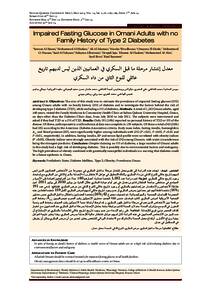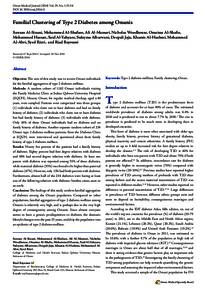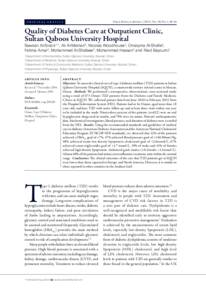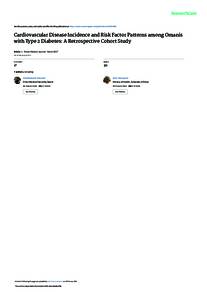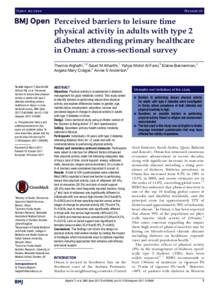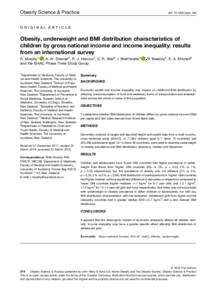Document
Impaired fasting glucose in Omani adults with no family history of Type 2 diabetes.
Contributors
Al-Shafaee, Mohammed., Author
Al-Mamari, Ali., Author
Woodhouse, Nicolas., Author
El-Shafie, Omayma., Author
Jaju, Deepali., Author
Al-Barwaniyah, Sulayma., Author
Al-Hashmi, Khamis., Author
Al-Abri, Mohammed., Author
Rizvi, Syed., Author
Bayoumi, Riad., Author
Hassan, Mohammed O., Author
Other titles
معدل إنتشار مرحلة ما قبل السكري في العمانيين الذين ليس لديهم تاريخ عائلي للنوع الثاني من داء السكري
Publisher
College of Medicine, Sultan Qaboos University.
Gregorian
2014-05
Language
English
English abstract
Objectives: The aim of this study was to estimate the prevalence of impaired fasting glucose (IFG)
among Omani adults with no family history (FH) of diabetes and to investigate the factors behind the risk of
developing type 2 diabetes (T2D), while excluding a FH of diabetes. Methods: A total of 1,182 Omani adults, aged
≥40 years, visited the Family Medicine & Community Health Clinic at Sultan Qaboos University Hospital, Oman,
on days other than the Diabetes Clinic days, from July 2010 to July 2011. The subjects were interviewed and
asked if they had T2D or a FH of T2D. Results: Only 191 (16%) reported no personal history of T2D or FH of the
disease. Of these, anthropometric and biochemical data was complete in 159 subjects. Of these a total of 42 (26%)
had IFG according to the American Diabetes Association criteria. Body mass index, fasting insulin, haemoglobin
A1C and blood pressure (BP), were significantly higher among individuals with IFG (P <0.01, P <0.05, P <0.01 and
P <0.01, respectively). In addition, fasting insulin, BP and serum lipid profile were correlated with obesity indices
(P <0.05). Obesity indices were strongly associated with the risk of IFG among Omanis, with waist circumference
being the strongest predictor. Conclusion: Despite claiming no FH of diabetes, a large number of Omani adults
in this study had a high risk of developing diabetes. This is possibly due to environmental factors and endogamy.
The high prevalence of obesity combined with genetically susceptible individuals is a warning that diabetes could
be a future epidemic in Oman.
Sponsorship
Sultan Qaboos University.
Member of
Resource URL
Arabic abstract
الهدف: تهدف هذه الدراسة إلى تقديرمعدل إنتشار مرحلة ما قبل السكري في مجموعة من الأشخاص العمانيين الذين ليس لديهم تاريخ عائلي للنوع الثاني من داء السكري، وكذلك التحقيق في عوامل الاختطار وراء الإصابة بالنوع الثاني من السكري مع إستبعاد وجود تاريخ عائلي للسكري. الطريقة: تمت دراسة عدد 182,1 شخصًا عمانيًا، أعمارهم 40 ≥سنة، من المراجعين لعيادة طب الأسرة والمجتمع في مستشفى جامعة السلطان قابوس،عمان،في غير أيام عيادة السكري خلال الفترة من يوليو 2010 إلى يوليو 2011 .تمت مقابلة الأشخاص والاستفسار عن إصابتهم بالسكري أو وجود تاريخ عائلي للنوع الثاني من مرض السكري. النتائج: النتائج: إدعى عدد 191 (16%) شخصًا فقط أنهم غير مصابين بمرض السكري أو عدم وجود تاريخ عائلي لديهم لمرض السكري. أكمل 159 شخصا فقط من هذه المجموعة القياسية الجسمية والبيوكيميائية. تم تصنيف مجموع 42 (26%) شخصا كمصابين باعتلال ما قبل السكري حسب معايير الجمعية الأمريكية لمرض السكري. كانت قياسات منسب كتلة الجسم، مستوى الإنسولين وقت الصوم، هيموغلوبين A1C، وضغط الدم مرتفعة بين الأشخاص الذين هم في مرحلة ما قبل ظهور السكري. وقد لوحظ أرتباط نسبة الانسولين وقت الصيام، وضغط الدم ونسبة الدهون في الدم مع مؤشرات السمنة. معدلات السمنة كانت مرتبطة بشدة بعامل الإصابة بمرحلة ما قبل السكري عند العمانيين، مع اعتبار كفاف الخصر منبئ قوي للإصابة. الخلاصة: على رغم الإدعاء من عدم وجود تاريخ تاريخ عائلي للاصابة بالسكري تم الاستنتاج أن عدد كبير من الأشخاص العمانيين في هذه الدراسة كان لديهم عوامل اختطار عالية للإصابة بمرض السكري. وهذا يعتبر نتيجة لعوامل بيئية وزواج الأقارب. أرتفاع معدل السمنة بالإشتراك مع الاستعداد الوراثي للشخص يعتبر تحذير من أن مرض السكري يمكن أن يتوطن في المستقبل في عمان.
Category
Journal articles

